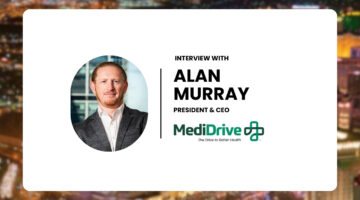
It could be years before a cell therapy from Nkarta reaches autoimmune disease patients in the market, but CEO Paul Hastings still thinks about the impact of pharmaceutical tariffs here and now. With blood from healthy donors, Nkarta isolates immune cells called natural killer cells, then engineers them for a new therapeutic purpose. The donor material comes from the U.S. and Nkarta manufactures its therapies at its own site in South San Francisco, but it’s misleading to call these biologic medicines all-American products.
Nkarta relies on chemicals and other materials from global suppliers. One key vendor, based in Germany, is the sole source of a particular instrument and related chemicals for Nkarta’s manufacturing process. Some of these chemicals expire after four to six months, making it difficult to stock up as a safeguard against supply chain disruption. Tariffs could make these items more expensive for the clinical-stage company.
“All of those pieces are in the supply chain, and many of those pieces are not coming from here, they’re coming from other places,” Hastings said. “What you’re doing [with tariffs] is you’re minimizing the opportunity to get good raw materials.”

NEMT Partner Guide: Why Payers and Providers Should Choose MediDrive’s TMS
Alan Murray on improving access for medical transportation.
It’s no longer a question of whether tariffs are coming, it’s how much they’ll cost. Pharmaceutical tariffs are now set to begin at the end of the month, putting them on a similar timeline as the so-called reciprocal tariffs for countries. President Trump has said a goal of pharma tariffs is to get drugmakers to bring manufacturing back to the U.S. But the supply chain in place today developed into a global network over decades, so untangling it and relocating it will be difficult and expensive.
Some pharmaceutical giants are responding with new manufacturing announcements. Those moves belie the fact that for many companies, big and small, there are pieces of the sprawling supply chain beyond their control. The challenges facing Nkarta offer just one example of the economic and technical complexities of a policy that calls for drugs made in America.
The WTO Pharma Agreement and the Rise of Globalization
The federal government settled pharmaceutical tariff policy more than 30 years ago. The U.S. is one of the countries party to a 1994 World Trade Organization (WTO) agreement that eliminated tariffs on finished pharmaceuticals and active pharmaceutical ingredients (APIs). The agreement is renewed periodically to update the items covered. As of the last update in 2010, more than 10,000 APIs are covered.

The Power of One: Redefining Healthcare with an AI-Driven Unified Platform
In a landscape where complexity has long been the norm, the power of one lies not just in unification, but in intelligence and automation.
With the WTO pharma agreement in place, some local taxes and customs duties still must be paid, but gone were the tariffs on the cross-border movement of drugs, said Ed Buthusiem, managing director in the healthcare practice at BRG, a consulting firm. The agreement has been in place for so long many people in the industry take it for granted that pharmaceuticals have not been subject to tariffs.
“Because of the WTO agreements, tariffs really aren’t something that companies have had to deal with for a long time, it simply was really not an issue,” Buthusiem said.
In 1994, the prevailing view was that China would grow into a major economy, and having good economic relations with the country was economically smart, said Rob Andrews, who is now CEO of the Health Transformation Alliance but was a Democratic congressman from New Jersey in the 1990s. Congress gave the WTO agreement overwhelming bipartisan support, but Andrews voted against it. He said he agreed with many of his colleagues that good trade relations with China were important, but he wanted more protections for the environment and intellectual property. Andrews added that his personal belief is Trump is now using tariffs as a negotiating tactic, but in a way that goes against years of broad bipartisan consensus that tariffs are appropriate only in situations of extreme economic unfairness.
“Trump is disrupting that consensus,” Andrews said. “It is kind of amazing to see the tables turn to see a Republican doing this. This wouldn’t have been [President Ronald] Reagan’s position, but it is Trump’s position.”
Uncle Sam Wants You… to Reshore Manufacturing
Concerns about the location of manufacturing came to a head during the Covid-19 pandemic, when the lack of domestic production manifest in shortages of key healthcare products. Drug manufacturing had left the mainland U.S. over the course of decades. In the 1970s, drug production moved first to Puerto Rico for tax advantages, then to Europe, former FDA Commissioner Janet Woodcock said in 2019 testimony to Congress. Eventually, China and India became major markets for drug and API production because of their significantly lower costs, she said.
The first Trump administration addressed manufacturing issues and drug shortages from the standpoint of emergency preparedness. The Coronavirus Aid, Relief, and Economic Security (CARES) Act signed in 2020 includes a provision requiring drug and API makers to develop and maintain risk management plans. But legislation alone has not brought manufacturing back from abroad.
Whether a manufacturing plant produces API or finished drug product, the decision about where to locate production is economic, Buthusiem said. Ireland grew into a pharmaceutical production hub because of tax advantages. If tariffs make overseas production economically disadvantageous, Buthusiem said companies might bring more production back to the U.S. But tax burden is just one of several factors that go into site selection. Labor, geopolitics, climate, and environmental factors are also considerations, he said.
The specter of tariffs has sparked a parade of pharma company announcements this year touting investment plans for U.S.-based manufacturing. This week, Biogen announced plans to spend $2 billion to expand its existing manufacturing presence in Research Triangle Park, North Carolina. AstraZeneca followed by pledging to invest $50 billion over the next five years at sites across the country. But it’s worth noting that big pharma companies were already rolling out major manufacturing announcements before tariff talk started heating up. For example, Eli Lilly and Novo Nordisk already had manufacturing initiatives well underway, both of them aiming to meet the overwhelming demand of their obesity and diabetes drugs that contributed to shortages that resolved only in the past year.
Even if a pharma company manufactures a drug in a U.S. facility, pinning down what could be subject to tariff is not straightforward. Well before a drug enters distribution channels, its various components move along a global supply chain — just like the materials for Nkarta’s cell therapies. Big pharmaceutical companies maintain overseas plants that make and supply bulk substance, the API in drugs, said Buthusiem, a GSK veteran. For drugs destined for the U.S. market, these ingredients are shipped to U.S. facilities for the final stage of manufacturing. Some of the new manufacturing facilities that big pharma companies have been announcing could be such fill and finish sites, he said.
In addition to API, drugs have inactive components called excipients, whose production is also global. A tariff could apply to the final drug product or its separate components. But even if the U.S. makes more excipients, APIs, and finished drugs, that does not necessarily spare Americans from pharmaceutical tariffs. The new U.S. drug manufacturing announcements rolling out have been for branded pharmaceuticals. Across all therapeutic areas, 90% of prescriptions in the U.S. are for generics, according to IQVIA. Generic drugmakers have not been hosting ribbon cuttings for multi-billion-dollar manufacturing plants in the U.S.
Challenges for Bringing Back Drug Production
While the U.S. has some generic drug manufacturing, most pharmaceutical products made in America are branded drugs, which have higher margins, said Diederik Stadig, an economist at the Netherlands-based bank ING. The lower costs of China and India make these markets a better match for the low margins of generics and their APIs. As an example, he pointed to doxycycline, a frequently prescribed antibiotic. Even though that generic drug is marketed by several U.S. companies, the API in that product comes from China.
The oral small molecules market has been a race to the bottom in pricing, said Stephen Farrelly, ING’s global lead of pharma and healthcare. Consequently, the low cost of these pills means a manufacturer has little room to maneuver to adjust to costs increases — from tariffs or construction of U.S. manufacturing plants. By pursuing tariffs, the Trump administration may find itself competing against its policy goals of lowering prices and easing shortages, Farrelly said. While new U.S. drug manufacturing will create jobs, those jobs will require higher salaries. A company would need to raise drug prices to cover construction and employment costs, making tariffs inflationary, he explained.
Many biologic drugs on the market are still protected by patents, so their higher prices still leave room for drugmakers to make money even if manufacturing moves to the U.S. But the specialization of biologic manufacturing creates higher barriers of entry for vendors, making it hard for drugmakers to find substitutes, Farrelly said. That affects companies like Nkarta. While some raw materials and consumable items in Nkarta’s manufacturing process are available from more than one commercial supplier, the company hasn’t confirmed their suitability, it said in its last quarterly report. Substitutes might cost more, be subject to delays, or require changes in the manufacturing process — which in turn delay clinical testing or force Nkarta to repeat a clinical trial.
Drug shortages were a problem before Trump proposed pharmaceutical tariffs, but tariffs could exacerbate them. The shortage risk is much higher for generic drugs versus branded products, said Bill Coyle, global head of biopharma at consultancy ZS. With such low prices, manufacturers for some generic medicines have dwindled to a few. For some generic products that sell in low volumes, there may only be a single source. Furthermore, the API might be in one or two sources, Coyle said.
The low prices of generic medicines diminishes economic incentive to keep a product on the market, U.S. Pharmacopeia (USP) said in its annual drug shortage report. If additional costs eat too much of the already thin margin, a company might just stop making a drug. By USP’s count, 46% of oral drugs discontinued last year had a price of less than $1 per pill.
Who Pays for Tariffs, and When?
Companies pass on the cost of tariffs in the form of higher prices for goods and services. But just as it’s not yet clear which part or parts of the pharma supply chain will be tariffed, it’s also unclear how and when patients will feel the impact. A drug’s price in the U.S. varies depending on what’s negotiated for a health plan. Coyle said some agreements are multi-year and may have clauses that limit price changes, which means passing on a drug price increase from tariffs might not be possible until the next contract negotiation.
“That makes it meaningfully harder to recoup those costs for contracted products — which is a lot of the products in the marketplace,” Coyle said.
The Health Transformation Alliance negotiates drug prices on behalf of member companies with self-insured employer health plans, firms such as Foot Locker, The Coca-Cola Company, and Marriott. Andrews said alliance members are concerned about increases to healthcare costs from tariffs, but their main worry is the broader economic impact. If tariffs lead consumers to cut back on purchases and travel, that’s bad for business. The agreements the alliance negotiates are typically annual. Andrews said if something happens during the contract term, such as a tariff, some contracts have provisions to permit a price increase.
Payers — private insurance companies and national healthcare systems — are price driven, ING’s Stadig said. If the Trump policy is to bring more generic drug production into the U.S., that requires rethinking of how much society is willing to pay for these medicines.
“I think that’s a good discussion to have in general, but it’s also a complex one,” Stadig said. “That creates uncertainty for generic manufacturers where if they invest in the U.S., prices would have to go up. But are you going to get reimbursed? And I think that’s sort of the fundamental discussion that underlies this.”
Firms may try to push some tariff cost on to consumers, said James Gellert, executive chair and former CEO of RapidRatings International, a financial technology company that assesses supply chain risk of public and private companies, including pharma companies. But Gellert also expects costs will be shared across the supply chain, which will test business relationships. The companies best suited to weather tariffs are those that collaborate with their suppliers, sharing financial information to figure out what a tariff means for a supplier’s ability to maintain inventory and deliver a good.
Tariffs mean a supplier must direct more capital toward covering the additional costs, Gellert said. That makes the supplier a weaker partner, not just because it’s financially weaker, but also because it might not be able to deliver goods on time — potentially contributing to shortages. Gellert added that reshoring manufacturing does not necessarily avoid tariffs. Even when a U.S. manufacturing plant uses U.S.-based suppliers, those suppliers might still source materials from abroad.
“You don’t necessarily know which of your new suppliers have tariff exposure, and that’s an irony here,” Gellert said. “In a perfect world, the administration would like to have all companies manufacturing in the U.S. But if that’s the case, every one of those companies is going to have less visibility into where their suppliers have foreign exposure.”
Changing Decades of Trade Policy in a Matter of Months
Trump has been offering snippets of detail about what pharmaceutical tariffs will look like. Earlier this month, he said they could be as high as 200% for certain pharmaceutical products. He also said drugmakers would have a grace period to shift their supply chains. Last week, the president said pharma tariffs would begin at the end of July with a low tariff to give companies “a year or so to build,” then they would rise to “a very high tariff.”
“The pharmaceutical companies are moving back to America, where they should be,” Trump said.
While a year or more gives companies time to build up inventory, that is not enough time to relocate an entire supply chain. New manufacturing, for both small molecules and biologics, is neither a short-term decision or a short-term fix, BRG’s Buthusiem said. It can take several years to bring a plant online. Beyond construction, the plant itself and the product produced at the site need to be cleared by the FDA before production starts. The FDA was already short-staffed to handle plant inspections before the Trump administration’s cuts to the agency, Buthusiem said. Now the agency is struggling to retain staffers who remain.
The WTO pharma agreement is still in place. Buthusiem said it’s unclear whether the Trump administration will renegotiate the pact or just ignore it. To Jonathan Todd, vice chair of the transportation & logistics practice group at the law firm Benesch, Friedlanders, Coplan & Arnoff, it’s an open question about what tariffs mean for historic trade treaties. But the basis for circumventing the WTO agreement and other trade pacts is coming from multiple inquiries underway by the U.S. Department of Commerce.
Under Section 232 of the Trade Expansion Act of 1962, the department may investigate the effects of imports on national security. The pharmaceuticals inquiry began April 1 and encompasses finished drugs, APIs, critical starting materials, and products derived from these items. A Section 232 investigation can take up to 270 days. But Trump’s timeline for imposing tariffs suggests the results are coming sooner. It’s a playbook Trump used for other industries during his first term.
In 2018, Section 232 investigations resulted in a 25% tariff on steel imports and a 10% tariff on aluminum imports. While some exemptions were granted at the time, product-specific exemptions were revoked last month and the tariff rate was increased to 50%. Todd said the president is continuing to carry out his own America-first trade policy.
“Many of the actions of this Trump administration are continuations of the Trump 45 administration,” Todd said. “There’s much more activity now and the policy objectives are much more ambitious. But the trend line is similar to eight years ago.”
Photo: Getty Images






